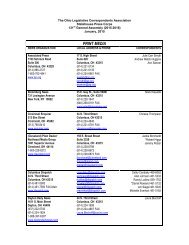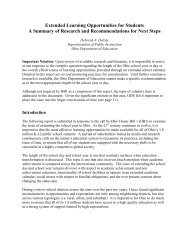dependent eligibility verification project - Gongwer News Service
dependent eligibility verification project - Gongwer News Service
dependent eligibility verification project - Gongwer News Service
You also want an ePaper? Increase the reach of your titles
YUMPU automatically turns print PDFs into web optimized ePapers that Google loves.
DEPENDENT ELIGIBILITY<br />
VERIFICATION PROJECT<br />
Executive Summary Report<br />
[03.22.10]
Dependent Eligibility Verification Project<br />
__________________________________________________<br />
Executive Summary<br />
The <strong>project</strong> involved a full <strong>verification</strong> audit of all State of Ohio benefit-enrolled <strong>dependent</strong>s to validate<br />
compliance with existing <strong>dependent</strong> <strong>eligibility</strong> rules. Compliance was confirmed by participant submission of<br />
specific documentation for each of their <strong>dependent</strong>s enrolled in State of Ohio medical, dental and vision plans.<br />
Coverage was cancelled for enrolled <strong>dependent</strong>s through voluntary notification by the employee or when the<br />
required documentation was not provided; thereby reducing unnecessary healthcare costs for the State of Ohio<br />
and helping the State to continue offering affordable and comprehensive benefits to eligible participants and<br />
their <strong>dependent</strong>s.<br />
One of the critical success factors for the State’s <strong>project</strong> was providing clear and consistent compliance<br />
education communications and support services to each participant, explaining the documents that were<br />
necessary to verify <strong>eligibility</strong>, and the deadline for assembling and submitting these documents. By employing<br />
multiple outbound contacts using various methods (letters, phone calls, and emails), a 24/7 inbound call<br />
center, and online compliance advocacy support services, the State of Ohio was assured that its participants<br />
had sufficient notification, support and time to submit the required documentation.<br />
Financial Impact<br />
$17,584,632 – First Year Estimated Benefit Cost Reduction<br />
40:1 – Project Return On Investment Estimate<br />
($17,584,632 cost reduction against $436,142 <strong>project</strong> costs)<br />
The total number of non-verified <strong>dependent</strong>s is 6,372 as of 12/18/2009. To calculate savings, we used the<br />
State’s average per <strong>dependent</strong> per year expense for medical, pharmacy, and mental health coverage. Due to<br />
the decision to allow re-instatements on a prospective basis for certain <strong>dependent</strong>s, the overall cost reduction<br />
may be reduced. The first year cost reduction breakdown by child and spouse can be seen in the table below:<br />
Child Spouse Total<br />
Cost/Dependent $ 1,914 $ 5,168<br />
# Non-Verified 4,716 1,656 6,372<br />
Year 1 Cost Reduction $9,026,424 $8,558,208 $17,584,632<br />
2
Verification Population Analysis<br />
In August 2009, the State of Ohio engaged Secova to audit <strong>dependent</strong>s enrolled in State of Ohio medical,<br />
dental and vision benefit plans. In total, after adjusting for terminations due to normal attrition (<strong>dependent</strong><br />
terminations that occurred as a result of employment terminations), 79,186 enrolled <strong>dependent</strong>s from 36,469<br />
benefit participants were subject to <strong>verification</strong> (total <strong>verification</strong> population includes 24 participants noted as<br />
suspended as of the end of the <strong>project</strong>. The <strong>dependent</strong>s for these participants are accounted for within this<br />
report).<br />
Over a period of 16 weeks, 95% of 36,469 State of Ohio benefit participants with enrolled <strong>dependent</strong>s<br />
provided documentation to confirm the <strong>eligibility</strong> of 72,814 <strong>dependent</strong>s, or 92% of the original enrolled<br />
<strong>dependent</strong> population still active as of the end of the <strong>project</strong>. In total, 6,372 <strong>dependent</strong>s (8%) were identified<br />
as ineligible during the term of the audit. Non-verified status was voluntarily reported for 3,087 <strong>dependent</strong>s or<br />
4% of the total population (2,519 children and 568 spouses). In addition, 3,285 <strong>dependent</strong>s or 4% of the total<br />
population (2,197 children and 1,088 spouses) could not be verified because no documentation was received<br />
or documentation was insufficient.<br />
State of Ohio - Employee Verification Status<br />
Verified<br />
95%<br />
Incomplete /<br />
Non-Responders<br />
5%<br />
Data effective as of 1/11/2010<br />
State of Ohio - Dependent Verification Status<br />
Verified<br />
92%<br />
Voluntary - Non<br />
Verified<br />
4%<br />
Incomplete /<br />
Non-Responders<br />
4%<br />
Data effective as of 1/11/2010<br />
3
Conclusion and Recommendations<br />
Dependent Eligibility Verification – Significant Findings<br />
Our analysis of the State’s <strong>dependent</strong> population determined the following:<br />
1) Need for improved controls to ensure ongoing compliance with overage <strong>dependent</strong> <strong>eligibility</strong><br />
30.60% of pre-audit students were dropped from coverage<br />
2) Need for improved controls to ensure compliance with <strong>dependent</strong> children <strong>eligibility</strong><br />
9.70% of pre-audit child <strong>dependent</strong>s were dropped from coverage<br />
Further, of the 6,372 <strong>dependent</strong>s that were dropped from coverage as of the end of the <strong>project</strong>, approximately<br />
52% (3,285) lost coverage due to either incomplete documentation or through no response by the participant.<br />
This population should be further evaluated to determine compliance education and communication<br />
effectiveness.<br />
Dependent Eligibility Management – Post Audit Recommendations<br />
Based on our audit findings and the $17,584,632 first year estimated benefit cost reduction achieved by this<br />
<strong>project</strong>, Secova recommends the following initiatives as part of a comprehensive <strong>dependent</strong> <strong>eligibility</strong><br />
management program be implemented in order for the State of Ohio to control <strong>eligibility</strong> of all enrolled<br />
<strong>dependent</strong>s and ensure continued financial and fiduciary protection of State benefit plans:<br />
Consolidate the enrollment and ongoing management of all State benefit participants and plans into a<br />
centralized system and process environment.<br />
Request all State benefit participants with enrolled <strong>dependent</strong>s to annually attest to the <strong>eligibility</strong> of<br />
every enrolled <strong>dependent</strong>.<br />
Request, collect, audit and maintain the required <strong>eligibility</strong> <strong>verification</strong> documentation from all benefit<br />
participants requesting a new <strong>dependent</strong> enrollment in an applicable benefit plan.<br />
Recertify on a scheduled basis the <strong>eligibility</strong> <strong>verification</strong> documentation for all <strong>dependent</strong>s enrolled in an<br />
applicable benefit plan.<br />
o Child Student – every 6 months<br />
o Child – every 3 to 5 years<br />
o Spouse – every 3 to 5 years<br />
Develop and maintain an ongoing <strong>dependent</strong> <strong>eligibility</strong> compliance education program<br />
4






